What’s the best way to tell area residents about plans for a new asylum shelter nearby?
The government should tell communities directly about plans for new asylum shelters, some activists and politicians say.
While a plurality of respondents said they wanted Option 3 for the planned Liffey Cycle Route, there are challenges to making it a reality.

Sometimes, Dublin City Council consultations attract a handful of responses. Not so, the Liffey Cycle Route. Around 1,200 people responded to that consultation request, and a plurality of them voted in favour of Option 3.
So it would seem like a done deal. But perceived flaws in the public consultation, concerns from affected residents, and worries over a conflicting planning permission have stopped councillors from endorsing the plan.
On 10 June, councillors on the Transport Strategic Policy Committee postponed a decision until next September’s meeting. In the meantime, they decided to visit the site to get a better understanding of the potential effects of choosing Option 3.
“I think there are deep, unresolved urban-design issues around running a major roadway around three sides of a park, and I’m not convinced that they’re solvable” said Ciaran Cuffe, North Inner City’s Green councillor and chair of the committee.
Cuffe also took issue with the consultation. He felt the detailed map files were too large and took too long to load. The inaccessibility of the map files, Cuffe thinks, led consultees to base their decisions on the four images provided.
Of the four images, one stands out. Options 1, 2, and 4 resemble the quays much as they are now – grey tarmac. The segregated cycle paths are the only discernible difference. Option 3, though, shows the Liffey Cycle Route running through a field of green along the riverbank. Here are options 1 and 3, one above the other, courtesy of Dublin City Council.
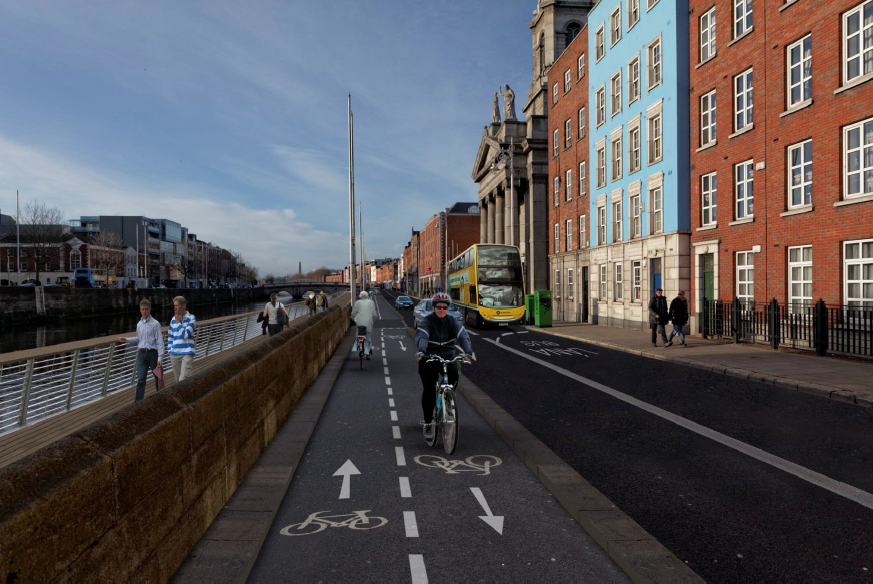
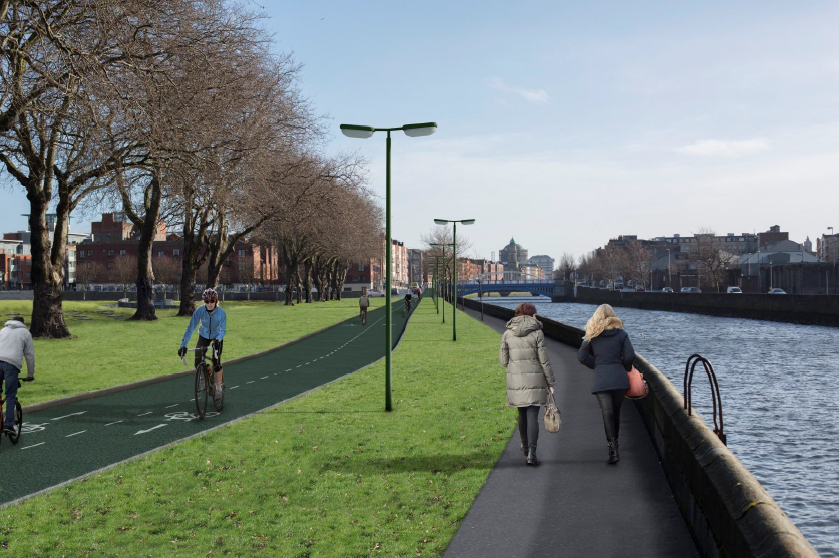
“What people did see,” said Cuffe, “was four images. One of which was bright green and practically had kids holding balloons in it . . . I think that influenced the consultation and I think the consultation was flawed.”
Fianna Fáil Pembroke-South Dock Councillor Frank Kennedy echoed many of Cuffe’s concerns over how the different Liffey Cycle Route options had been presented.
But Kennedy also raised concerns that Option 3 would make it more difficult for motorists to get around the city. “Dublin is so difficult to get around already, and I’m just not totally convinced of the merits of it as yet.”
Cuffe added after that he feels strongly about the matter, “possibly because I favour Option 1 and I see that Option 3 was strongly supported.”
Option 3 would reroute traffic on the quays around Croppies Acre memorial park. The stretch of roadway along Wolf Tone Quay would be removed and Croppies Acre extended to the riverfront.
Colm Ryder of the Dublin Cycling Campaign says he supports Option 3 “because it’s making a statement about the city. About the future of Dublin”. Ryder thinks Option 3 would bring the Liffey back into the city, giving people “the opportunity to engage with the river”.
Labour Councillor Andrew Montague was present at both Liffey Cycle Route stakeholder workshops, the first of which was held back in 2012. He says he’s always supported Option 3.
“I love the idea of having a chunk of what has been a really busy motorway taken away,” says Montague. “And on the river we’d have a park for pedestrians and cyclists. Fantastic.”
Both Ryder and Montague believe Option 3 would best meet the movement needs of Dublin’s cyclists and enhance Croppies Acre, a sadly underutilised green space in the city.
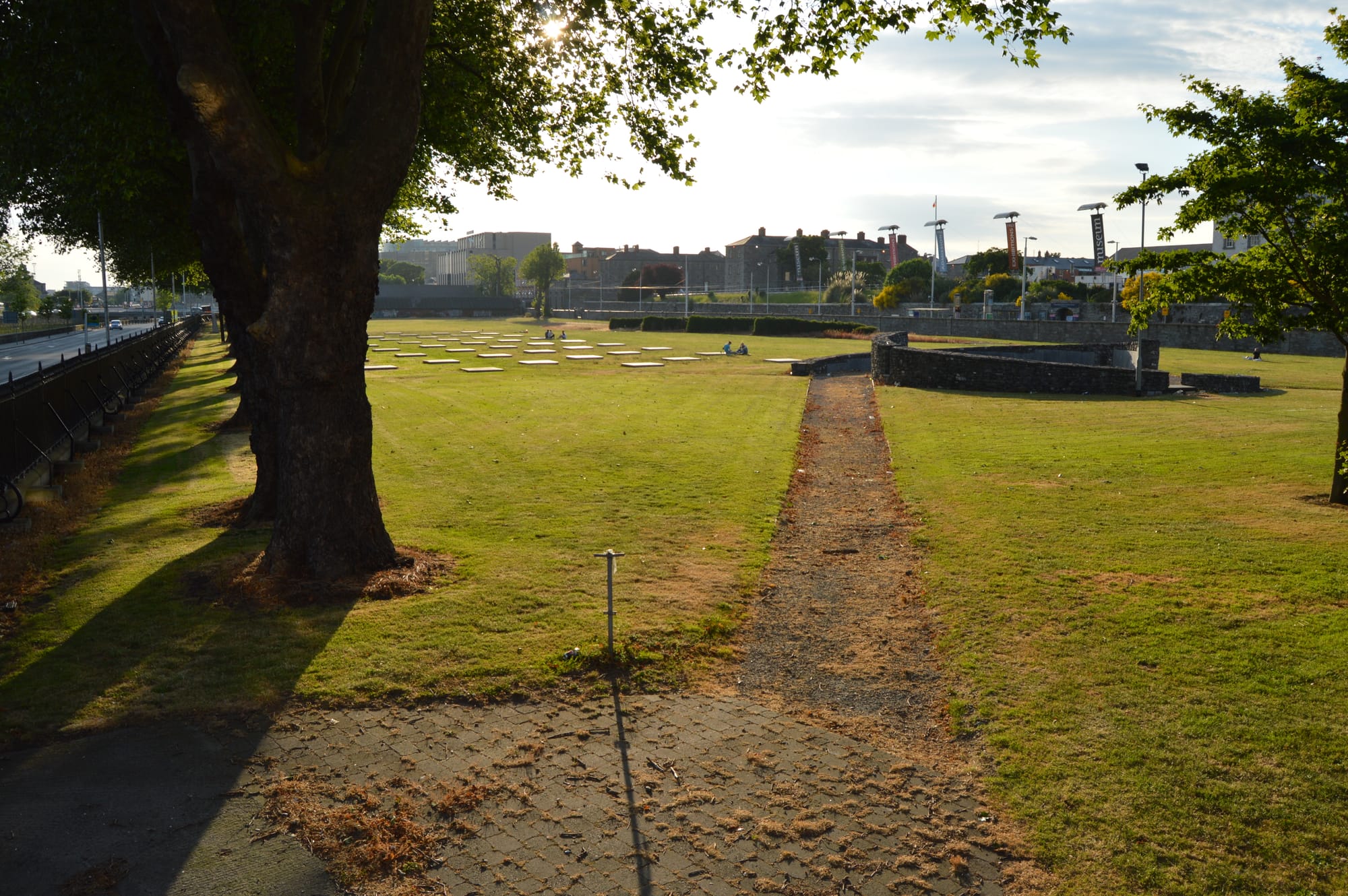
In 2011 the city invested €35,000 into renovating the park, but the improvements weren’t enough to attract the kind of activity that prevents antisocial behaviour from taking root.
Drug users took to Croppies Acre, littering the grass with dirty syringes. The problem grew until the gates to the park were padlocked in 2012. The Office of Public Works (OPW) said they could no longer keep the park safe for the public.
Montague thinks inaccessibility is a major reason Croppies Acre fell into decline. “There’s four lanes of traffic on one side and two lanes of traffic on the other side of it; it’s just a hostile park to get to, so people don’t use it.”
Montague thinks that through removing traffic and bringing the park to the banks of the Liffey, Croppies Acre would be transformed into “a very attractive park, right in the heart of our city”.
Several residents and apartment-complex managers from Parkgate and Benburb Street have contacted Dublin city councillors to voice their disapproval of Option 3. They worry about more traffic coming through their neighbourhoods, and feel they haven’t been consulted directly.
“Making this determination without consulting management of the only apartment complex on Liffey Street West is such a blatant oversight that it invalidates the entire ‘public consultation’ process,” according to the managers of an apartment complex on Liffey Street West that faces Croppies Acre.
The month-long consultation was posted on a cycling organisation’s website, and therefore directed towards cyclists and not the broader public, argued directors of the Collins Square Management Company in a 20-point tirade against Option 3. (It was also posted on the main Dublin City Council website.)
They also think the introduction of a bus lane on Benburb Street “will create a dead street for people”. Pedestrians will be stuck on narrow footpaths on either side of a busy bus lane and the Luas tracks, they said.
The upset apartment-complex managers may be in luck. A site that the city council needs to become a road if Option 3 is going to work is earmarked for an apartment complex.
Permission has been granted for a six-floor mixed-use apartment building in Smithfield, right on the plot of land that Option 3’s bus diversion was meant to use.
Option 3 reroutes buses along the south side of the Luas tracks on Benburb Street. Once the buses reach Smithfield, the idea is that they will turn down Phoenix Street in front of the courthouse, on their way to Church Street. It’s easy to see in this Dublin City Council sketch:
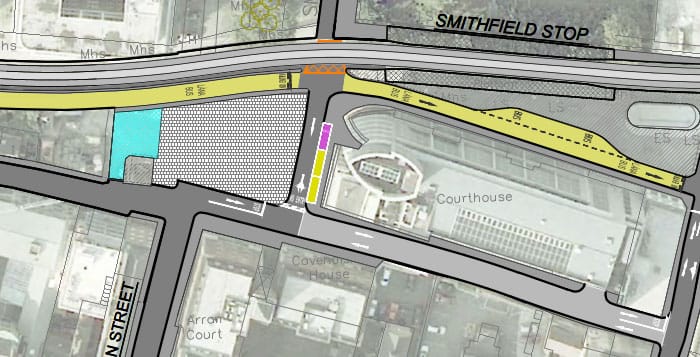
The problem is that there may not be enough space for a bus lane between the Luas tracks and the area highlighted in baby blue on the map above. The bus lane would need to cut into the baby-blue area and likely take a bit of space from the plaza south of the tracks before making its way onto Phoenix Street.
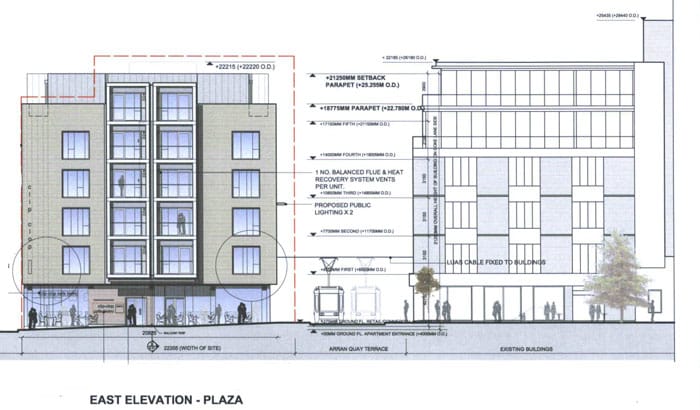
On 12 December 2014, the owners of the plot of baby-blue land were given planning permission for a six-storey mixed-use development. The architect’s elevations make one thing clear: there isn’t enough space between buildings for a bus to run alongside the Luas.
At the time of our conversation, Montague wasn’t sure if planning permission had been given to the discordant development. “If they have gotten planning permission already, that’s going to cast doubt on option number three. We may have to look at other options,” he said.
The Dublin Cycling Campaign’s Colm Ryder, who is a civil engineer, was optimistic that any problems could be designed away. “There’s always an answer to issues like that,” he said.
Visit the site, though, and it’s evident that development has already begun.
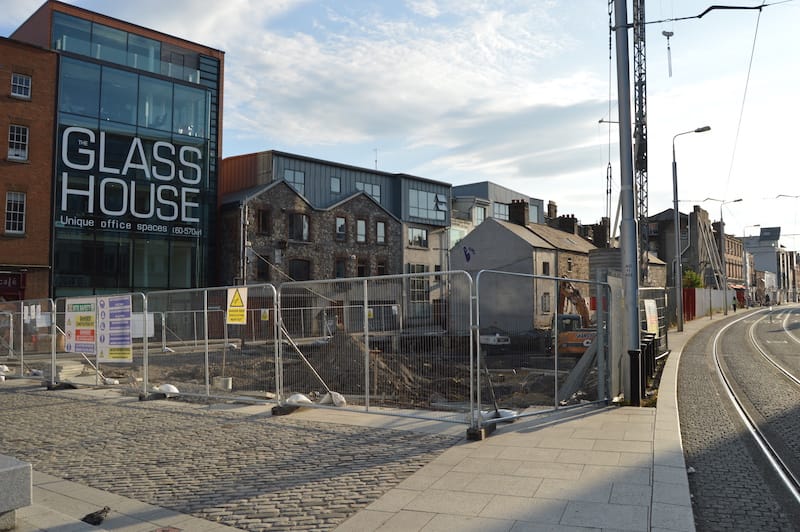
For Option 3 to work, the buses must rejoin the quays before this point. The engineers may need to go back to the drawing board. The upset apartment-complex managers may get their chance to weigh in again.